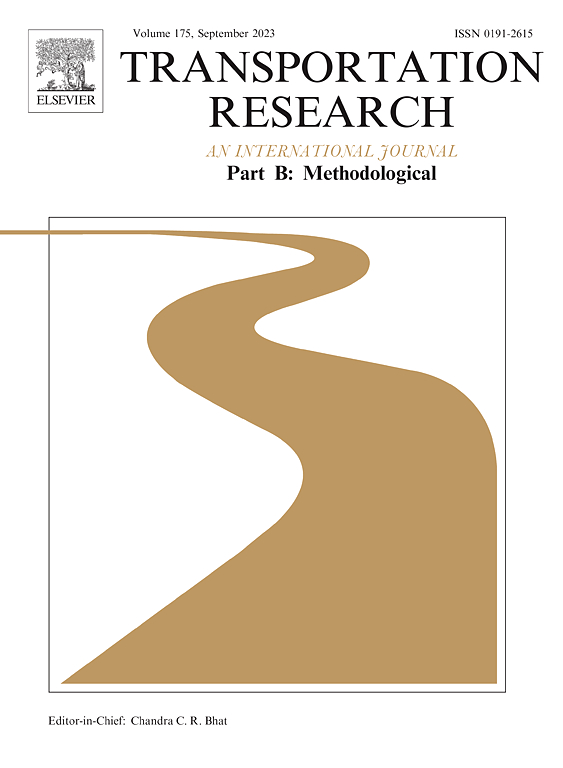基于车辆轨迹数据的在线自适应冲击波检测与涂装:严格的算法设计与理论发展
IF 6.3
1区 工程技术
Q1 ECONOMICS
引用次数: 0
摘要
交通冲击波作为不同交通状态的边界,捕捉了交通波动形成和传播的时空特征。对冲击波的监测有助于实时交通管理和控制,从而提高交通效率和安全性。然而,由于交通动态的复杂性和有限的数据收集,检测冲击波具有挑战性。现有的方法要么需要事先了解冲击波才能在特定的交通场景中检测它们,要么只能检测具有近似传播速度的部分冲击波。为了解决这些限制,本研究开发了一种有效的在线冲击波检测和修复方法,该方法使用在广泛的交通场景中收集的车辆轨迹数据(标记为SWIFT)。简而言之,首先注意到分段线性回归的拐点与车辆经历显著速度变化的每个单独轨迹曲线上的断点之间的相关性,我们通过将分段线性回归与冲击波特征约束进行更新,开发了一种新的自动断点识别方法。接下来,我们设计了一种自适应数据驱动的在线冲击波检测方法,该方法无需任何冲击波的先验知识即可运行。该方法根据冲击波传播特性对断点进行顺序分类和连接,生成具有数学上保证误差边界的分段线性波形轨迹。考虑到数据驱动方法检测到的冲击波通常是不完整的,我们建立了理论基础,包括关键定义、推论和一个基于冲击波特征几何表示的指导冲击波绘制和缺失冲击波揭示的定理。在此基础上,我们开发了一种基于部分轨迹数据逐一验证激波端点的生成算法,以修复不完整的激波并揭示缺失的激波。利用NGSIM数据集进行的数值实验验证了SWIFT在不同数据采集设置(如渗透率、检测窗口大小、采样间隔)和不同交通场景下的准确性、自适应性和鲁棒性。本文章由计算机程序翻译,如有差异,请以英文原文为准。
Online adaptive shockwave detection and inpainting based on vehicle trajectory data: rigorous algorithm design and theory development
Traffic shockwaves, as the boundary of distinct traffic states, capture the temporal-spatial characteristics of traffic fluctuation formation and propagation. Monitoring shockwaves facilitates real-time traffic management and control to improve traffic efficiency and safety. However, detecting shockwaves is challenging due to the complex nature of traffic dynamics and limited data collection. Existing methods either require prior knowledge of shockwaves to detect them in specific traffic scenarios or are capable of detecting only partial shockwaves with approximated propagation speed. To address these limitations, this study develops an eFfective online ShockWave deTection and Inpainting approach using vehicle trajectory data (labeled as SWIFT) collected in broad traffic scenarios. Briefly, first noticing the correlation between turning points for piecewise linear regression and breakpoints on each individual trajectory curve where a vehicle experiences significant speed changes, we develop a novel automatic breakpoint identification method by renovating the piecewise linear regression with shockwave features’ constraint. Next, we design an adaptive data-driven online shockwave detection approach that operates without any prior knowledge of shockwaves. This approach sequentially classifies and connects breakpoints based on shockwave propagation characteristics to generate distinct piecewise linear shape shockwave traces with mathematically guaranteed error bounds. Considering the shockwaves detected from data-driven approaches are usually incomplete, we establish the theoretical foundation including critical definitions, corollaries, and a theorem to guide shockwave inpainting and missing shockwave revealing based on the geometry representation of shockwave features. Built upon that, we develop a generative algorithm that verifies shockwave endpoints one by one based on partial trajectory data to repair incomplete shockwaves and reveal missing shockwaves. The numerical experiments using the NGSIM dataset demonstrated the accuracy, adaptiveness, and robustness of the SWIFT under various data collection settings (e.g., penetration rates, detection window sizes, sampling intervals) and different traffic scenarios.
求助全文
通过发布文献求助,成功后即可免费获取论文全文。
去求助
来源期刊
CiteScore
12.40
自引率
8.80%
发文量
143
审稿时长
14.1 weeks
期刊介绍:
Transportation Research: Part B publishes papers on all methodological aspects of the subject, particularly those that require mathematical analysis. The general theme of the journal is the development and solution of problems that are adequately motivated to deal with important aspects of the design and/or analysis of transportation systems. Areas covered include: traffic flow; design and analysis of transportation networks; control and scheduling; optimization; queuing theory; logistics; supply chains; development and application of statistical, econometric and mathematical models to address transportation problems; cost models; pricing and/or investment; traveler or shipper behavior; cost-benefit methodologies.

 求助内容:
求助内容: 应助结果提醒方式:
应助结果提醒方式:


